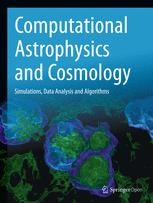Cosmological N-body simulations: a challenge for scalable generative models
 Perraudin, N., Srivastava, A., Lucchi, A. et al. Cosmological N-body simulations: a challenge for scalable generative models. Comput. Astrophys. Cosmol. 6:5 (2019) https://doi.org/10.1186/s40668-019-0032-1
Perraudin, N., Srivastava, A., Lucchi, A. et al. Cosmological N-body simulations: a challenge for scalable generative models. Comput. Astrophys. Cosmol. 6:5 (2019) https://doi.org/10.1186/s40668-019-0032-1
Research Article | Open Access
Published: 19 December 2019
Part of the Collection "Machine learning to advance our understanding of the Universe"
Abstract:
Deep generative models, such as Generative Adversarial Networks (GANs) or Variational Autoencoders (VAs) have been demonstrated to produce images of high visual quality. However, the existing hardware on which these models are trained severely limits the size of the images that can be generated. The rapid growth of high dimensional data in many fields of science therefore poses a significant challenge for generative models. In cosmology, the large-scale, three-dimensional matter distribution, modeled with N-body simulations, plays a crucial role in understanding the evolution of structures in the universe. As these simulations are computationally very expensive, GANs have recently generated interest as a possible method to emulate these datasets, but they have been, so far, mostly limited to two dimensional data. In this work, we introduce a new benchmark for the generation of three dimensional N-body simulations, in order to stimulate new ideas in the machine learning community and move closer to the practical use of generative models in cosmology. As a first benchmark result, we propose a scalable GAN approach for training a generator of N-body three-dimensional cubes. Our technique relies on two key building blocks, (i) splitting the generation of the high-dimensional data into smaller parts, and (ii) using a multi-scale approach that efficiently captures global image features that might otherwise be lost in the splitting process. We evaluate the performance of our model for the generation of N-body samples using various statistical measures commonly used in cosmology. Our results show that the proposed model produces samples of high visual quality, although the statistical analysis reveals that capturing rare features in the data poses significant problems for the generative models. We make the data, quality evaluation routines, and the proposed GAN architecture publicly available at https://github.com/nperraud/3DcosmoGAN.
